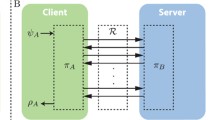Abstract
Recent work has shown how to use the laws of quantum mechanics to keep classical and quantum bits secret in a number of different circumstances. Among the examples are private quantum channels, quantum secret sharing and quantum data hiding. In this paper we show that a method for keeping two classical bits hidden in any such scenario can be used to construct a method for keeping one quantum bit hidden, and vice–versa. In the realm of quantum data hiding, this allows us to construct bipartite and multipartite hiding schemes for qubits from the previously known constructions for hiding bits.
Similar content being viewed by others
References
P. O. Boykin and V. Roychowdhury, “Optimal encryption of quantum bits”, LANL e-print quant-ph/0003059.
A. Ambainis, M. Mosca, A. Tapp, and R. de Wolf, “Private quantum channels”, in IEEE Symposium on Foundations of Computer Science (FOCS), pp. 547–553, 2000; LANL e-print quant-ph/0003101.
R. Cleve, D. Gottesman, and H. K. Lo, “How to share a quantum secret”, Phys. Rev. Lett. 83(3), 648–651 (1999); LANL e-print quant-ph/9901025.
B. M. Terhal, D. P. DiVincenzo, and D. W. Leung, “Hiding bits in Bell states”, Phys. Rev. Lett. 86(25), 5807–5810 (2001); LANL e-print quant-ph/0011042.
D. P. DiVincenzo, D. W. Leung, and B. M. Terhal, “Quantum data hiding”, IEEE Trans. Information Theory 48(3), 580–598 (2002); LANL e-print quant-ph/0103098.
T. Eggeling and R. F. Werner, “Hiding classical data in multi-partite quantum states”, LANL e-print quant-ph/0203004.
C. H. Bennett and S. Wiesner, “Communication via one-and two-particle operators on Einstein–Podolsky–Rosen states”, Phys. Rev. Lett. 69(20), 2881–2884 (1992).
C. H. Bennett, G. Brassard, C. Crépeau, R. Jozsa, A. Peres, and W. K. Wootters, “Teleporting an unknown quantum state via dual classical and Einstein–Podolsky–Rosen channels”, Phys. Rev. Lett. 70, 1895–1899 (1993).
D. Gottesman, “Theory of quantum secret sharing”, Phys. Rev. A 61(4), 042311(2000); LANL e-print quant-ph/9910067.
J. Jamiołkowski, “Linear transformations which preserve trace and positive semidefiniteness of operators”, Rep. Math. Phys. 3(4), 275–278 (1972).
C. E. Shannon, “Communication theory of secrecy systems”, Bell System Tech. J. 28, 656–715 (1949).
M. A. Nielsen and I. L. Chuang, Quantum Computation and Quantum Information (Cambridge University Press, 2000).
Author information
Authors and Affiliations
Rights and permissions
About this article
Cite this article
DiVincenzo, D.P., Hayden, P. & Terhal, B.M. Hiding Quantum Data. Foundations of Physics 33, 1629–1647 (2003). https://doi.org/10.1023/A:1026013201376
Issue Date:
DOI: https://doi.org/10.1023/A:1026013201376




